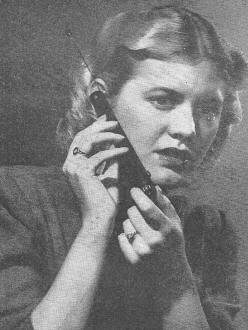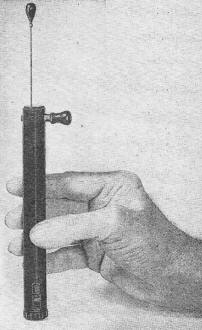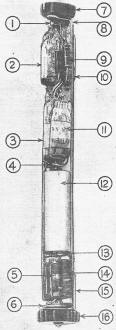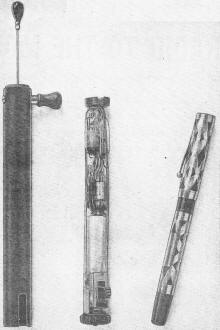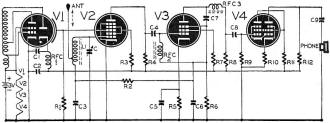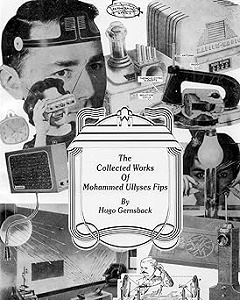Now - A Radio Pen
|
|
Well-known radio communications futurist, visionary, and inventor Mohammed Ulysses Fips, I.I.R.R.E.E., published an article in the April 1946 issue of Radio-Craft magazine. He described a portable, compact, fully functional two-way radio disguised to look like an ink pen - the "Radio Pen." It measured approximately 3/4" in diameter and about 6" in length. Like early cellphones, the antenna was not a conformal internal job, but need to be extended externally for use. When I first saw the Radio Pen, it reminded me of the ones used by playboy spy Napoleon Solo and nuclear physicist spy Illya Kuryakin in the old television series "The Man from U.N.C.L.E." (United Network Command for Law and Enforcement). Whilst on assignment tracking down a THRUSH (Technological Hierarchy for the Removal of Undesirables and the Subjugation of Humanity) bad guy or girl, the master spies would covertly remove the cover of their pen communicators, attach it to the bottom of the pen, and initiate contact back at U.N.C.L.E. headquarters using the "Open Channel D" code phrase. No explanation of why "D" was chosen as the preferred channel, but I suspect it is suggestive of the women often featured as victims, bad guys, and U.N.C.L.E. HQ staff - or not. Melanie and I own The Man from U.N.C.L.E. DVD set and watch an episode every couple months. Sure, it's hokey, but it was meant to be a spoof of then-popular spy movies. Get Smart (which we also own) was the same way. Now - A Radio Pen 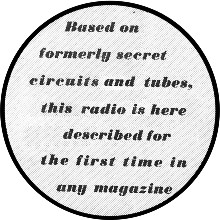 By Mohammed Ulysses Fips, I.I.R.R.E.E.* By Mohammed Ulysses Fips, I.I.R.R.E.E.*
Based on formerly secret circuits and tubes, this radio is here described for the first time in any magazine. Not so long ago, the Boss-Editor called me into his sanctum, handed me a big cigar and, with one of his rare smiles, asked me to be seated. I immediately observed that the cigar was not one of the Chief's usual stogies, but an expensive import, which I knew to be the brand of one of our big advertisers who goes in for fancy cigars. "Fips, my boy," began the Editorial Oracle, "we have a most important project before us today which requires immediate and concentrated attention. One of our top advertisers, the Utis Electronic Corporation, who, as you know, use page advertisements right along, wishes to go into production as fast as possible on a new radio set. This innovation is nothing less than a new miniature radio which is to be called the Radio Pen. "This particular radio must be the size of a fountain pen, not longer than six inches, and small enough to be carried in the upper vest pocket alongside a fountain pen and pencil. "I have worked out all the preliminary details, as you will see from the detailed sheet, which I hand you herewith. This is only a rough, sketch giving you but a mere outline what our advertiser wants. They have asked us to do the work for them, inasmuch as all their good engineers are still in Uncle Sam's service and will not return for some time. I immediately felt that the only radio engineer qualified to do the job justice would be you." Here The Boss handed me another cigar - a most unusual occurrence - which I took as a great personal compliment and I stammered my thanks. The All Highest then went on to say that the model would have to be ready in thirty days, and to hurry the project under forced draught, day and night at full speed. I was to keep track of all expenses carefully and confer with him at least once a week until the Radio Pen was completed. The Radio Pen is put into action by switch at bottom, just above tuning knob. Earpiece projects from the side. The Mahatma then made some unusual - for him compliments on my past work and wished me luck. (He didn't give me another cigar.) Everything went well and after long, heartbreaking weeks, the Radio Pen was duly evolved. Indeed, I take the greatest pride in this unusual development, which, to the best of my knowledge has not been attempted before. It becomes immediately clear to any radio engineer that there are numerous difficulties to overcome in engineering a workable radio set in the small space of a normal pen. Nevertheless, the problem was brilliantly solved as will be apparent from these pages. Not only was the Radio Pen engineered in the space of thirty days, but the Utis Electronic Corporation went into immediate production of this intricate new radio. This will be seen from the photographs which appear here. As the photographs attest, the Radio Pen measures approximately six inches without the extended aerial. The latter measures another six inches when fully extended. Normally it is pushed into the "pen" and takes up no room, except the small top knob which extends slightly. The pen measures 3/4-inch in diameter and, therefore, fits the vest pocket; it can also be carried in a lady's purse. It only weighs three ounces. Chassis of the Radio Pen. 1 - Coupling piece of speaker which contacts external earpiece. 2, 3, 10, 11 - Miniature vacuum tubes. 4 - Connector for batteries. 5 - The condenser block. 6 - Tuning condenser. 7 - Miniature crystal speaker. 8 - Chassis and ground wire. 9 - Condenser block. 12 - Battery block. 13 - Bottom battery connector. 14 - Primary tuning inductor. 15 - Aerial connector. 16 - Tuning wheel. The entire "chassis" is rigid and all parts are removable for replacement. The Radio Pen was not designed as a loud-speaking radio; it is of a purely personal type. The earpiece which extends slightly, is placed in one's ear, then the bottom switch is pushed which instantly puts the set into operation. Tuning is done by the bottom wheel in the usual way. The Radio Pen covers the full range of the broadcast band. The illustrations give full details and the circuit diagram also makes everything clear to the radio man. There are a number of technical details, which I would like to enumerate here. In a small instrument of this type, it becomes apparent that there is not sufficient space available for a regulation "chassis." Instead, I used a central support, which in this case is a plastic rod 1/16-inch in diameter upon which the top part of the set is built. There is a similar supporting rod for the bottom. As the set is built, it is held together by two "chassis wires," which run around all the components as clearly seen in one of the photographs. This gives the set not only compactness, but makes the entire "chassis" rigid. The circuit, as you will note, is a four-tube superheterodyne, which follows conventional engineering practice. I use a special crystal speaker, which gives clear reproduction and brings in local stations with excellent volume. The tuning condenser is of the compression, variety, with certain novel refinements. As several patents are pending on this particular phase, I cannot here give the exact details of the development. As will be noted from the illustrations, as well as the circuit diagram, only an "A" battery is used for power purposes. There is no "B" battery. I found that this was a necessary requirement, simply because there was no space available for a "B" battery; even the new smallest type was too big. The "A" battery is the new and modern mercury-oxide type. It gives longer service than the ordinary carbon type battery. This new battery, incidentally, was used extensively during the war as, for instance, in the famous Radio Fuze, described in Radio-Craft in the December 1945 issue. By inspecting the circuit diagram, it will be seen, immediately, that as far as the power supply is concerned an entirely new engineering principle had to be evolved. Inasmuch as no "B" batteries are used, but as it is necessary to have a tension of at least 90 volts, in order to operate the vacuum tubes, I have recourse to a new radio principle, used rarely for high voltage, low-current purposes. This I term "Electronic Power Regeneration." The following gives an outline of the principle: The receiver is so designed that every tube, except the power-generating tube itself, works on the resistance principle. To this end, a crystal earphone is used in the output circuit, so that even this stage is resistance-operated. Thus currents are lower - and voltages higher - than in the usual portable radio. The one special tube in the circuit (V1) is an oscillator-rectifier. It is so designed as to oscillate readily on the three volts supplied by the uni-battery. The oscillating circuit, as will be seen from Fig. 1, is part of an r.f. auto-transformer, high-voltage output from which is fed into the rectifier section of the tube. Filtered by the r.f. choke, RFC-1, and condensers C1 and C2, d.c. at a voltage of approximately 180 is supplied to the other tubes. The electronic generator tube, VI, is of a gas type. Sufficient free ions are generated in the rectifier section to materially reduce its internal resistance without producing complete ionic breakdown of the gas, which would prevent oscillation. Thus larger currents can be produced by the oscillator than might be expected from the low plate voltage. Another feature of the tube is that the oscillating frequency is so set that it is used for the mixer. The other tubes are standards belonging to the super-miniature N-E series. Some of these may look a trifle strange to the layman, but will be readily recognized by persons who have been engaged in certain secret war work. A special feature of these tubes is the, sprayed cathode. The filament is coated with insulating material and the conductive cathode splattered directly on top of it. Other information on these tubes will be available shortly. There is only one tuned circuit in the set. This makes it possible to use a fixed oscillator frequency, taken from VI by capacitive coupling to the injector grid of V2. The intermediate frequency stage is resistance coupled and untuned. Thus, though each station tuned in has a different i.f., all are amplified equally well. The combination of short antenna and high-Q tuning coil (L1) gives ample selectivity for the purposes of this receiver. Operation of V3 is interesting. Working first as i.f. amplifier, it rectifies the i.f. signal an its suppressor grid (U. S. Patent No. 2,346,545). The rectified signal is again applied to the grid through RFC-2 and amplified at audio frequency. Automatic volume control is also furnished by the diode section of this circuit. As Patent restrictions still exist on some of the tubes and circuit features of this receiver, further information, circuit constants, etc., cannot be divulged at present. Enough has been said, however, to make it clear that this is a remarkable receiver circuit. You will observe that the miniature vacuum tubes had to be specially engineered to meet the electronic requirements explained above. With the present advance of vacuum tube building there was not a great deal of difficulty in solving the various tube problems. Indeed future developments will probably make it possible that an equally excellent set can be evolved with only two tubes instead of the four shown here. In the present model, the set is sufficiently sensitive to bring in with satisfactory volume all local stations and some distant ones, even if the Radio Pen is used inside a steel-frame building. The set performs similar to any four-tube superheterodyne under similar conditions. One of the first pens to come off the assembly lines is photographed and shown in these pages. The case is in black plastic, as is the earpiece. Soon other models will be made in a variety of colors to match any color scheme demanded by the eventual user. Other models will be made in metal such as sterling silver and 14-karat gold. The latter are not anticipated to be produced until fall. The original price for the Radio Pen (for the lowest priced model) was set at $15.00, but the O.P.A. has not as yet approved this price, nor any of the higher-priced types. There is no question that there will be a very insistent demand for the new Radio Pens once they are manufactured in sufficient quantities. Needless to say, I am extremely proud of this development, in which I played such a prominent part. *** After I had written the above and thought back of the long sleepless nights which I had spent in developing the Radio Pen, I thought - as who would not - that I was entitled to a few weeks well-earned rest. Accordingly, I was getting ready to depart for Florida with this idea in mind. On the day of departure there came a hurry call from the Big Boss and I repaired myself to his Throne Room with ill-forebodings. Immediately upon entering into his office, I sensed that the air was indeed charged wish high electronic tension. One look at The Sultan did not reassure me one whit. He was chewing his usual big, black stogey, and scowled fiercely. About 60 Decibels. His usual ruddy complexion had taken on a vivid apoplectic Prussian blue. I thought I could even detect small flicks of blue foam near his lips - but in this I may have been mistaken. Without further ado he exploded into this atomic outburst: "Of all the incompetent, idiotic, nincompoops, you, my asinine Fips, are tops! Here-look at this." With that he handed me a bulky sheaf of papers neatly stapled together with pale blue legal wrappings. I divined it immediately as an extra generous law suit, which the Metorola Radio people had instituted, not only against the Utis Electronic Corporation, but also against The Sheik and his magazine, as the chief partners in crime. Not being too well versed in complicated, technical legalities, I tremblingly asked The Maharajah just what this was all about. "You super-regenerated idiot," bellowed the now fully aroused Grand Mogul, "if you had left a spark of honesty in your decrepit, short-circuited carcass, and if you had not been a cockeyed commonplace copycat, you would have known that the Metorola people have copyrights, trade marks, patents, habeas corpuses on ANY portable radio set from which a telescopic aerial extends from the top, and which set is used by placing it against the ear. "Have you ever heard of or seen a handie-talkie in your past, miserable and worthless life? Perhaps that would be too much to expect from a low-oscillating moron of your type. When I gave you the original plans I just sketched the barest outline of the Radio Pen. I naturally supposed that you would not copy obvious designs prevalent in the radio industry. But that was expecting too much of a blown tube of your type! "Why must you radio engineers continuously steal ideas from each other? Is there no originality in this world? Why couldn't you think up a new-fangled loop aerial instead of copying the handie-talkie type, which you know is covered (and roofed over) by dozens of fundamental, chromium-plated acid-proof patent claims? "Now observe into what a sticky mess you have gotten the Utis Electronic Corporation, as well as myself. Not only are we going to be the laughing stock of the whole radio world, but it will cost us thousands of dollars to get out of it. On top of this, the entire Radio Pen has to be designed all over again. Now the first thing I am going to do is get YOU out of it - not only out of this mess, but OUT entirely. You are not only OUT, but you are fired as well-NOW!" . During this monstrous high-potential harangue The Shah had become almost incoherent. He was sputtering like a live trolley wire snaking dangerously on the ground. In a flash he picked up one of the latest Radio Pens and flung it at my head. I ducked out of its path in less time than it takes a radar signal. In making this lightning-like exit, I could not help noticing that the Radio Pen - my own creation - hit squarely against the big calendar not far from the door. I noticed also, with some surprise, the date: it read: APRIL 1 * International Institute Royal Radio Exegetic Engineers.
Posted April 1 ,2021 The Collected Works of Mohammed Ulysses Fips (note the misspelling of Ulysses) These Mohammed Ulysses Fips articles appeared in Radio−Craft and later in Radio−Electronics magazines, by in what I am sure is sheer coincidence all appear in April issues (beginning in 1944)!
|
|

